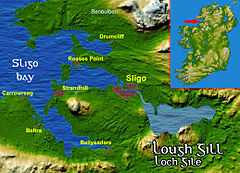Lough Gill
| Lough Gill Loch Gile | |
|---|---|
 | |
| Location | County Sligo & County Leitrim, Ireland |
| Coordinates | 54°15′N 08°22′W / 54.250°N 8.367°WCoordinates: 54°15′N 08°22′W / 54.250°N 8.367°W |
| Primary outflows | River Garavogue |
| Max. length | 8 km |
| Max. width | 2 km |
| Islands | ~20 |
| Settlements | Sligo |
Lough Gill (Irish: Loch Gile) is a freshwater lough (lake) mainly situated in County Sligo, but partly in County Leitrim, in Ireland. The lake is strongly associated with the poet W. B. Yeats.
Geography
Lough Gill is about 8 km or 5 miles long and 2 km or 1 mile wide, and drains into the River Garavogue near Sligo Town. The picturesque lake is surrounded by wooded hills and is popular with birdwatchers.[1] It is overlooked by Parke's Castle. Slish Wood, Dooney Rock, and Hazelwood also contain popular nature trails and viewing points along the lake, and the wooded highlands of Slieve Killery and Slieve Daean loom over the south shore.
Islands
The lake contains about 20 small islands, including the Isle of Innisfree, made famous by W. B. Yeats,[1] Church Island, and Beezie's Island, which was inhabited until 1951.
History

In the early historic era (5th-8th centuries), it was home to a branch of the Cálraighe. The present castle was built in the 17th century by Captain Robert Parke on the site of the former stronghold of the Uí Ruairc clann. The Uí Ruairc clan ruled the area from about the 7th century up to the time of Oliver Cromwell.[1]
The two largest islands on Lough Gill, namely, Church Island or Inis Mor, and Cottage Island, each contain ecclesiastical remains. An early Christian ruin lies on Church Island and belonged to the O' Rourkes, chieftains of Breifnet. In 1416, according to the Annals, 'the church of Inis Mor was burned, and Screaptra O Curnin and the Leabhar Gearr of the O' Curneens, as well as many other precious objects, were burned.' The church is said to have been founded by St Loman. The building is oblong, has loophole windows and a recess at one end. Near the door there is a cavity in a rock, known as 'Lady's Bed', which was a frequent place of pilgrimage for pregnant women. St Loman, whose feast day is on 4 February, is mentioned in the Martyrology of Tallaght. The ruin on Cottage or Gallagher's Island belonged to the church of Kilross, in Riverstown parish, which in turn belonged to the Premonstratensians of Trinity Island on Loch Ce.[2]

The lake is home to the Lough Gill 10 km Swim for the North West Hospice in Sligo. This annual fundraiser began in 2011 raising over €34,000 to date for the hospice also winning the coveted Irish Long Distance Swimming Association swim of the year in both 2011 and 2012. It is run by a committee made up of local swimmers and friends of the family of Neill McGarry, for whom the event trophy is dedicated. 57 swimmers completed the 2012 swim.[citation needed]
The first man to successfully swim the English Channel, Captain Matthew Webb, used the lake as part of his training for the feat. He was a friend of W.B. Yeats's grandfather, who lived in the area.[citation needed]
Gallery
-

Innisfree
-

Parke's Castle and Lough Gill
-

Green Island, Lough Gill, with Kilkenny Mountain in background
-

Lough Gill, circa 1900
-

Slish Wood forest trail
See also
- List of loughs in Ireland
- Naisse mac Cithruadh
References
- ↑ 1.0 1.1 1.2 , Lough Gill Tours
- ↑ St Josephs and Calry parish history
External links
- Sligo Walks (Slish Wood)
- McDonagh, Marese. Irish Times, "Poetry in motion on Yeats Day boat trip", June 14th 2012